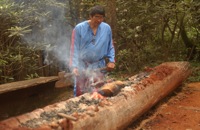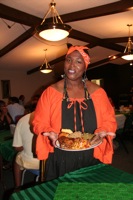 Photo courtesy Tampa Bay and Co.
Photo courtesy Tampa Bay and Co.
In the South, culture, history and flavor come in a variety of colors.
Since North America was discovered, folks from all over the world have traveled here, and many settled in the South. Along with their families, they brought food, music, art and stories.
In many ways, the story of the South is the story of the many ethnic groups that settled there. And although time has brought a blending of nationalities throughout the region, in many places, the histories and heritages of ethnic groups are still strong.
Groups traveling through the region today can find rich cultural experiences in many different places. From stories of Native American beginnings to those of the Civil Rights Movement, there are tales to be heard wherever you go.
Eastern Band of Cherokee Indians
North Carolina
Although many of the Native Americans of the South were forced west on the Trail of Tears in the 1830s, some remained on their ancestral homelands. In North Carolina, the Eastern Band of Cherokee Indians comprises about 13,000 people, who now invite travelers to visit and experience their culture.
 |
| Courtesy Cherokee Travel and Promotions |
“When I put together a group tour package, a lot of people like the hands-on stuff here in Cherokee,” said Frieda Huskey, the receptive tour coordinator for Cherokee Travel and Promotions. “We like to get their hands on our culture.”
Many groups start with a tour of the area led by Cherokee step-on guides who are well versed in the tribe’s history. The tours often stop at Oconaluftee Village, a historic re-creation that shows what Cherokee life in the area was like in the 1700s. Interpreters demonstrate activities such as basketweaving and pottery for visitors.
Tours also let participants have firsthand experience with Cherokee culture.
“A lot of groups that we’ve dealt with are interested in our culture and history and doing hands-on stuff,” Huskey said. “So we have some craftspeople that will teach groups to make a honeysuckle mat to take home with them, or they can teach them to do beadwork.”
The Cherokee offer traditional meals to guests, serving dishes such as native bean bread, rainbow trout and native greens. Guides will also take visitors on nature walks, pointing out plants and animals that were key to traditional native life.
African American heritage
Atlanta
As the Civil Rights Movement of the 1950s and 1960s gained steam, many of the key leaders lived or spent time in Atlanta. The city’s Auburn Avenue neighborhood was at the epicenter of African American progress during that time.
 |
| Courtesy Atlanta CVB |
“With Dr. King as the focal point, Auburn Avenue was one of those streets that had all kinds of names in the ’50s, like the Wall Street of black America,” said Kathleen Bertrand, senior vice president of community and governmental affairs for the Atlanta Convention and Visitors Bureau. “There was so much businesses, and the businesses were African American owned. This was the center of activity for all things related to the black community.”
Today, visitors to Atlanta can learn about African American heritage and the birth of the Civil Rights Movement at several attractions around Auburn Avenue. The most prominent is the Martin Luther King Jr. National Historic Site, which includes the home where King was born in 1929 and Ebenezer Baptist Church, his original place of worship. Groups can go inside the buildings on prescheduled tours that are guided by park rangers.
Beyond the historic buildings, the King site features a welcome center, a museum and the International Civil Rights Walk of Fame. King and his wife are buried at the site. Visitors can see all of these areas on ranger tours or take a 45-minute podcast walking tour of the neighborhood, which is narrated by civil rights activist Andrew Young.
Atlanta will also soon welcome a new civil rights attraction in its downtown tourism district, near the World of Coke and the Georgia Aquarium.
“In 2012, the Center for Civil and Human Rights is coming,” Bertrand said. “It’s going to offer visitors insight into the contributions made by Atlantans and Georgians in the civil rights struggle.”
Ybor City
Tampa, Fla.
In the late 19th century, a large influx of immigrants from Cuba brought a distinct Latin flavor to the Tampa neighborhood called Ybor City. Today, visitors can still experience the heritage of Cuba and of other countries that makes Ybor City unique.
“Ybor City was always a place where immigrants were welcomed,” said Lindsey Guthrie, manager of national public relations for Tampa Bay and Company. “The neighborhood was named after a Cuban refugee who came here in hopes of starting a new life. He brought his cigar industry to Tampa Bay, and it thrived for many years.”
Ybor’s cigar business sparked others as well, and by the late 1800s, there were more than 200 cigar factories employing some 1,200 workers in Ybor City. At one point, it was the largest cigar-producing community in the world, turning out more than 700 million cigars every year.
Groups touring Ybor City can still see cigars being rolled by hand at two different factories in the area or they can arrange to have an expert come and do a private demonstration. Beyond that, there are numerous other ways to enjoy the area’s culture, from historic restaurants, shops and hotels to the Ybor City State Museum.
“The museum is the authority on all that is historical in Ybor City,” Guthrie said. “It’s a beautiful place to walk through — they have a great collection of photography and artifacts from the cigar culture.”
The museum staff can also take groups on historical tours of the neighborhood or evening ghost tours.
Cajun country
Lafayette, La.
When the descendents of the French Acadians were expelled from Nova Scotia in 1765, many made their way south to Louisiana, which was also French territory at the time. In the area around present-day Lafayette, their culture survived and thrived, and the name morphed from “Acadian” to the more prominent “Cajun.”
“Some of the Acadians ended up here in south Louisiana,” said Kelly Strenge, public relations manager for the Lafayette Convention and Visitors Bureau. “They lived in an area that was pretty inaccessible, so their culture remained pure, and they developed new traditions. They lived off the land, which is why we eat things like crawfish, which other people wouldn’t eat.”
Groups can begin learning about the Cajun culture in Lafayette at the Acadian Cultural Center, a facility run by the National Park Service. The museum has exhibits detailing the culture of the Cajun people, as well as two films that depict their expulsion from Nova Scotia and their historic lifestyle in southern Louisiana.
Cajun culture comes to life next door at Vermilionville, a folk life attraction.
“There are people there in costume demonstrating crafts and music, and they talk about their history, culture and traditions,” Strenge said. “It’s a 23-acre village setting, and you walk from building to building. They have a schoolhouse, several homes, a plantation house and a church.”
Groups interested in Cajun cuisine can participate in a cooking school at Vermilionville or visit one of several restaurants in Lafayette that offer authentic Cajun meals. Three Cajun restaurants in town also feature live Cajun and zydeco music seven nights a week.
Gullah culture
Beaufort, S.C.
A blend of nationalities combined with the relative isolation of the South Carolina barrier islands produced the Gullah culture, a distinctive flavor of African American heritage found only in the coastal area of the state.
 |
| Courtesy ASE Gullah Education |
“Gullah is a culture that came from the transatlantic slave trade in the 1700s and 1800s,” said Anita Prather, director of ASE Gullah Education, a group that produces Gullah heritage festivals and events. “It’s the blending of West African culture with European culture, and it continued once they arrived on the shores of North and South America. Because of the isolation of these islands, the Gullah people could continue to practice their religious beliefs and traditional medicine.”
Gullah people and their distinctive language and practices can still be found in some of the rice plantation areas around Beaufort and other parts of South Carolina. They come together to celebrate their heritage during a number of special events throughout the year.
The four-day Gullah Festival takes place over Memorial Day weekend, and features lectures, dance groups, African drummers, storytelling and other entertainment. The festival is based around the Gullah tradition of Decoration Day, in which people decorate the graves of their loved ones at the local cemetery.
During the summer months, groups traveling to Beaufort can take part in Gullah Caribbean Night, an event that features a Gullah buffet, singing, storytelling and history. At Christmastime, a production called Freedom Rising gives visitors a glimpse inside historic plantation life.
“It’s set in 1860, the last Christmas on the islands before the Civil War,” Prather said. “We give you a glimpse of what’s going on in the big house and what’s going on in the quarters. Part of that evening is called A Taste of Gullah — we have six or seven local caterers bring out their Gullah dishes, and it’s like a minifestival with the production.”










